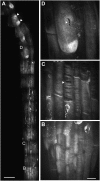Real-time imaging of cellulose reorientation during cell wall expansion in Arabidopsis roots
- PMID: 19965966
- PMCID: PMC2815888
- DOI: 10.1104/pp.109.150128
Real-time imaging of cellulose reorientation during cell wall expansion in Arabidopsis roots
Abstract
Cellulose forms the major load-bearing network of the plant cell wall, which simultaneously protects the cell and directs its growth. Although the process of cellulose synthesis has been observed, little is known about the behavior of cellulose in the wall after synthesis. Using Pontamine Fast Scarlet 4B, a dye that fluoresces preferentially in the presence of cellulose and has excitation and emission wavelengths suitable for confocal microscopy, we imaged the architecture and dynamics of cellulose in the cell walls of expanding root cells. We found that cellulose exists in Arabidopsis (Arabidopsis thaliana) cell walls in large fibrillar bundles that vary in orientation. During anisotropic wall expansion in wild-type plants, we observed that these cellulose bundles rotate in a transverse to longitudinal direction. We also found that cellulose organization is significantly altered in mutants lacking either a cellulose synthase subunit or two xyloglucan xylosyltransferase isoforms. Our results support a model in which cellulose is deposited transversely to accommodate longitudinal cell expansion and reoriented during expansion to generate a cell wall that is fortified against strain from any direction.
Figures







References
-
- Baskin TI (2005) Anisotropic expansion of the plant cell wall. Annu Rev Cell Dev Biol 21 203–222 - PubMed
-
- Bruck H, Evans J, Peterson M (2002) The role of mechanics in biological and biologically inspired materials. Exp Mech 42 361–371
Publication types
MeSH terms
Substances
LinkOut - more resources
Full Text Sources
Other Literature Sources

